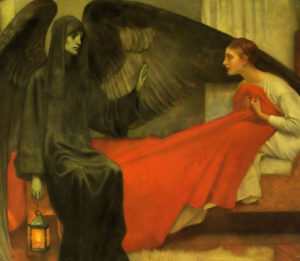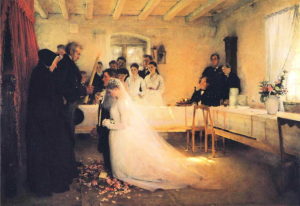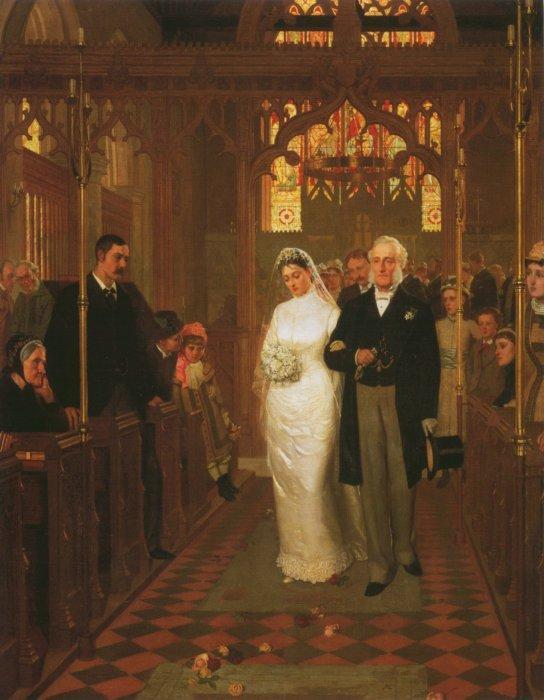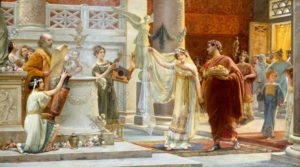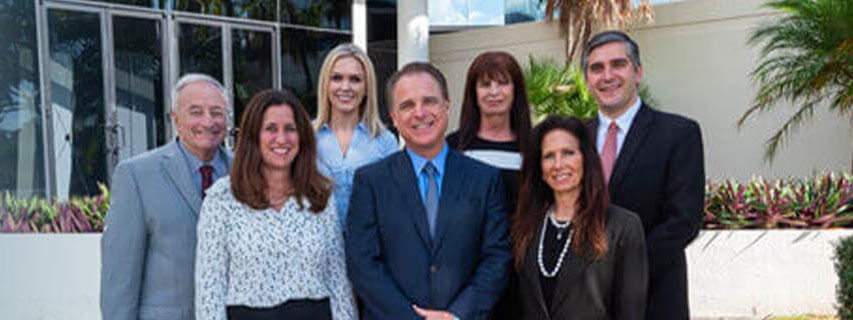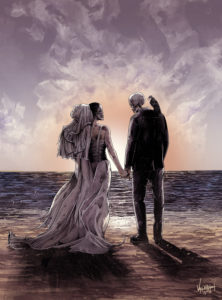
Til Death Do Us Part II by J.P. Valderrama, 2017
A brief examination of the differences between the society which birthed the ‘Until death do us part’ worldview and that of contemporary America provides several fascinating insights. Contrasting the past with the present is worthy of consideration as so many social mores and laws concerning marriage and divorce have evolved. This transformation of values, however, has not always been uneven. Divorce has been made legally easier to obtain. And yet in many social settings, the opinion remains that marriage that ends before death is a sign of failure. Because of this, a desire to avoid feelings of guilt, shame, embarrassment, fear, and dishonor in the eyes of family and friends function as strong inhibitors for effectuating divorce – even if your spouse has a pathological, narcissistic personality disorder.
This social dynamic has made some Seek Alternatives to ‘til Death Do Us Part’. By knowing even a little about the history of marriage, it becomes apparent that this judgment rooted in nostalgia – i.e. “a few decades ago marriage meant a real life-long commitment” – is based on a misunderstanding of the generations that predate the present. The rise in life expectancy, the transformation of the church and state’s role in marriage, and the transformation of values, attitudes, and beliefs towards marriage in the English-speaking world over the past five hundred years shows that ‘until death do us part’ is a far more complicated standard than it appears at face. By contrasting the life expectancy, marital norms, and social views on the purpose of marriage between the cultures which birthed the ‘as long as you both shall live’ standard and the present enables appraisal of this worldview and its value for the modern age. Doing so helps provide insights as to why the legal system has increasingly come to support people in romantic relationships who want the freedom to start fresh.
“Until Death Do Us Part” in Light of a Short Life Expectancy
For centuries, marriage in the English-speaking world has been regarded as a contract that ended only when one partner was no longer alive. The phrase “until death do us part” was first popularized in the English-speaking world following the first printing of the Book of Common Prayer in England in 1549. In God Talk, published in New Yorker magazine, Harvard professor of literary criticism James Wood provides a history of the book’s publication and traces its influence. He cites several well-known, high-brow British authors, David Bowie songs, and Neville Chamberlain’s use of the phrase “Peace for our time”. Were the article updated today, Wood would likely include the Marvel Cinematic Universe in his list of traces. Ironman/Tony Stark and Ultron have both adopted “Peace in our time” as a motivating, quasi-religious maxim.
The passage from the vows which end in ‘until death do us part’ begins with a commitment to stay together “for better, for worse, for richer, for poorer, in sickness and in health”. The wording of this rite denoting permanent spiritual union is compelling poetry. And yet it’s important to note that at the time that marriage was evolving into an institution, the human lifespan was almost half of what it is today.
H.O. Lancaster was an Australian mathematical statistician affiliated with the University of Sydney that was awarded the Order of Australia for his work in math. Lancaster’s study “Expectations of Life” offers an in-depth look at the life expectancy of English males before and after the period of the Book of Common Prayer was published. Lancaster collected a large body of data on the births and deaths of the aristocratic class, those most likely to be noted in such registers, from the years 1200 through 1745.
Below is a timeline of life expectancy by 50-year periods that depicts his findings:
- 1200-1300: 43 years
- 1300-1400: 24 years
- 1400-1500: 48 years
- 1500-1550: 50 years
- 1550-1600: 47 years
- 1600-1650: 43 years
- 1650-1700: 41 years
- 1700-1745: 43 years
Considering that the aristocratic class then, as now, was more likely to live longer, it’s likely that the actual average life expectancy was several years lower than the ages listed here.
Following the publication of research by Londoner and proto-epidemiologist John Snow, whose research on the cholera epidemic had a tremendous impact on life in cities all over the world, along with the social advocacy of barrister Edwin Chadwick, the First Public Health Revolution began. The non-medical social improvements Snow and Chadwick helped initiate, such as public water treatment, food inspection, and waste management, would radically raise the average life expectancy rate. The later development of antibiotics like penicillin and advanced surgical techniques raised this number even more.
What this means is that over the past 200 years the length a marriage was expected to last according to this view has more than doubled. If a couple married in 1600 when each was 24 and then died at 43, they’d have been married for 19 years. That same couple today is statistically, according to the World Bank, likely to live until 81. This means is that this marriage would last for 57 years – which is 3 times as long as it was 400 years ago.
What this means is that the midlife crisis that Brides author Cathy Meyer warns wives about and that PsychCentral and Healthline describe so that men can have information on how to be resilient in the face of distress was something that most of these women never faced. Similarly, the midlife crises which Cleveland Clinic describes women as going through were something that most men never dealt with. While supporting your partner in times of crisis is a core marital value – its extension across such a long period is novel. This is not the only aspect of marriage that has changed.
Marriage: From Personal to Institutional
In addition to the rise of life expectancy that has impacted marital relations, the role of religious and state institutions has also evolved alongside a transformation of what marriage means. According to the author of Marriage, a History: How Love Conquered Marriage, Stephanie Coontz, in the article The World-Historical Transformation of Marriage: “For more than a thousand years, the Catholic church took the position that if a man and woman claimed that they had exchanged words of consent, whether in the kitchen or out by the haystack then they were married.” (Coontz 974). Similarly, according to sociologist Dr. Carol Smart of the University of Manchester, it wasn’t until 1793 and the passage of the Clandestine Marriage Act that state involvement in marriage was significant. This act, effectively, ended the protections granted by common law marriage.
Dr. Smart shared with the BBC that the act marked the beginning of state involvement by requiring couples to get married by a minister in a church or chapel otherwise the union would be considered invalid. Though by that time America had separated from England via political revolution, according to historic researches affiliated with PBS, many of the cultural values were still the same.
The United States went through a similar transformation. Common-Law was adopted by the Colonies, however, in the 1800s, various states began to repeal these rights. According to the National Conference of State Legislatures, only eight U.S. states recognize common law marriage: Colorado, Iowa, Kansas, Montana, New Hampshire, South Carolina, Texas, and Utah.
The depiction of marriage shown in the above painting made is, in other words, relatively modern. Somber and public religious ceremonies of that type were infrequent. When they did happen, it usually served to publicize the joining of two families with mutual political or economic interests.
Marriage: From Economic to Emotional
That political motivation was the primary influence for marital motivation in royal family’s is common knowledge, less widely known is that economic concerns were the primary motivation for the non-aristocratic classes. For hundreds of years, families in this class would arrange the marriages of their children to further their economic interests. The children of leather tanners would marry the children of shoemakers, the children of prosperous farmers of grain would marry millers. Such arrangements helped consolidate economic activity – which would eventually lead to the rise of family-owned craft and industrial firms.
Such practices were also evident in the United States as well as England. Harvard historian Sven Beckert describes in The Monied Metropolis: New York City and the Consolidation of the American Bourgeoisie how the children of the owners of American industrial firms in the 19th century arranged the marriages of their children to those of the owners of mining companies, shipping firms, and British aristocrats to improve their business operations while Jackson Lears, a History professor at Rutgers University, in No Place of Grace: Antimodernism and the Transformation of American Culture, describes the familial ties which came to link cotton processing operations in England with plantations owners in the South.
As wealth accumulated over generations could be dissipated by an unwise alliance or the profligacy of an intemperate bachelor, parental pressures continued to promote the attitude that romantic love was not the most important consideration. Parents, however, could not match the influence of the views transmitted through literature and popular culture. Just as the Public Health Revolution promoted personal health practices, novels and short stories promoted the notion that the emotional union experienced via romantic love was far more desirable to look at marriage as a means to create strategic alliances. Marriage without love was described as stultifying, a cause for depression, it vindicated infidelity and all sorts of behaviors that would otherwise be unjustifiable.
The transformation happened over hundreds of years. According to Coontz’s research, “it’s only in the last 50 years or so that we’ve been marrying for love at all.” The modern understanding of love and marriage is that there is now one person for us that is to address all of the needs once fulfilled by friends, family, and others within one’s lived environment. This worldview places many new expectations on our spouses and can be both fulfilling and cause troubles that are novel. This view of love and marriage as divorced from the traditional roles which mandated child-rearing has impacted marriage in broader ways.
Dr. Coontz’s History of Love or: How I learned to Stop Worrying and Love Divorce
One recent example of the evolution of marriage in the United States stems from the Supreme Court’s 5-4 decision in the Obergefell v. Hodges case on June 26, 2015. The decision held that state statutes against same-sex marriage and states that refuse to recognize same-sex marriages that occurred in jurisdictions that did allow it violated the due process and equal protection clauses of the Constitution. It’s worth noting that the Majority Opinion, written by Justice Kennedy, twice cited Marriage, a History: How Love Conquered Marriage by Dr. Stephanie Coontz. This expansion of what marriage means along with other changes – such as the increase in no-fault divorce laws – have led some commentators to claim that marriage and the family as an institution as well as American society as a whole are harmed.
The answer to the National Bureau of Economic Research’s question Is Making Divorce Easier Bad for Children?, for example, is yes. Using 40 years of census data segmented by states which allow for unilateral divorce, they highlight how such laws result in lower family incomes and children with lower education levels. But is this the whole story? Not at all. For one basing a broad argument on just two indicators is poor social science. The human experience is incredibly complex and a few statistics rarely reflect that. Secondly, there’s an important and unaddressed counterfactual. Jewish people have long accepted marriage as a spiritual binding that can be legally ended by no-fault divorce, called a get, and yet their religion’s share of household income is the highest in the United States and the Pew Research Center published research in 2016 which stated that they are the best-educated religious group.
When marriage is conceived of as something invariable and ‘unto death’, any ambiguity or change can seem like an assault on what is seen across all human cultures as a spiritual merging of two people. And yet history shows that marriage as a rite and institution is often being adjusted to the everyday realities people face.
Conclusion
Perceptions of marriage and the practices linked to it have varied drastically across different periods, regions, religions, and ethnic groups. As a cultural rite, custom, and institution – marriage has evolved alongside developments in law and society. In England, geopolitical concerns linked to royal succession helped lead to the normalization of divorce. Controversies tied to economic issues helped end the legal view that women become the property of men. In the United States after riots, pleas, protests, and considerations within the political sphere and rulings via the judicial process about marriage resulted in new civil norms being created. In the English-speaking world, and elsewhere, what was once primarily an economic arrangement influenced by political, religious, and financial concerns evolved into an emotional covenant.
Marriage is fundamentally different now than it was 100 years ago. What marriage was 100 years ago was far different than it was 100 years before that. And what will marriage be like in 100 years? Who knows! If research findings described by Emily Willingham in Scientific American are true and life expectancy can be “hacked” so that life expectancy rises to 150 years, it’s certain to be different than it is now. Whatever comes to be, there is cause to ignore the prognostications of alarmists as to the future of marriage. National Center for Health Statistics data on Marriage and Divorce shows that over the past decade the U.S. divorce rate has recently declined. Data analysts have also published research that shows that the oft-cited “50% divorce rate” is inaccurate.
Societies make their own history, but they do not make it as they please. They do not make it under self-selected circumstances, but under circumstances existing already, given, and transmitted from the past. Understanding the historic shifts in the values, attitudes, beliefs, and laws linked to marriage can provide happily married couples cause for appreciation of what they now have. It can also give those in unhappy relationships fortitude in the face of social pressures which keep them in a relationship that has become dysfunctional. Until death do us part is certainly beautiful poetry. And yet history shows that when high aspirations cannot be reached, especially when our lives are now so much longer than the culture which first created that verse, we ought not to deny ourselves the freedom to start fresh due to social pressures.
